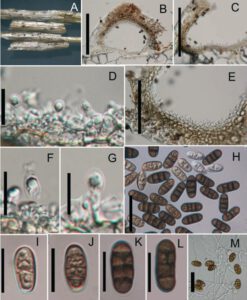Pseudocamarosporium lonicerae Wijayaw., Camporesi & K.D. Hyde, in Wijayawardene, Hyde, Bhat, Camporesi, Schumacher, Chethana, Wikee, Bahkali & Wang, Cryptog. Mycol. 35(2): 188 (2014)
Index Fungorum Number: IF 550558; Facesoffungi number: 000018
Etymology – Named after the host, Lonicera
Holotype – MFLU 14-0091
Saprobic on stems of Lonicera sp. Sexual state: Not observed. Asexual state: Conidiomata pycnidial, 160-180 µm diam., 140-160 µm high, solitary, dark brown, immersed, unilocular, with a papillate ostiole. Pycnidial wall multilayered, with 3-4 outer layers of brown-walled cells of textura angularis, inner layer with hyaline cells. Conidiophores reduced to conidiogenous cells. Conidiogenous cells enteroblastic, with percurrent phialidic development, hyaline, smooth, formed on the inner layer of pycnidium wall. Conidia 12-19 × 5-7 µm (› = 15.3 × 4.6 µm, n = 20), oblong, mostly straight, rarely slightly curved at the base, muriform, with 3 transverse septa, with 1-2 longitudinal septa, guttulate when young, pale brown to brown at maturity, smooth-walled.
Culture characteristics – on PDA white from above and pale brown from reverse, circular, flat, slow growing, attaining a diam of 2 cm in 7 days at 18°C.
Material examined – Italy, Forlì-Cesena Province, Forlì, Via del Partigiano, on stem of Lonicera sp. (Caprifoliaceae), 09 March 2013, E. Camporesi, NNW IT 1104 (MFLU 14-0091, holotype; isotype PDD 104438), living culture MFLUCC 13-0532 = ICMP 20370 = GUCC 0011.
Notes – Several Camarosporium species have been recorded from Lonicera sp. viz. C. caprifolii Brunaud (12-15 × 5-6 fide Brunaud, 1887), C. lonicerae S. Ahmad (22-26 × 7.5-9 µm fide Ahmad, 1971), C. periclymeni Oudem. (16-20 × 6-7 fide Oudemans, 1898), C. polymorphum (De Not.) Sacc. (10 × 8 fide Saccardo, 1884) and C. xylostei Sacc. (18-20 × 8 fide Saccardo, 1884). Camarosporium caprifolii has conidia of similar size to our collection, but with only one longitudinal septum (Brunaud, 1887). Molecular data analyses show that our taxon is not congeneric with Camarosporium sensu stricto (Figs 1 and 2). Hence we introduce our collection as a new species in Pseudocamarosporium.

Fig. 1. Pseudocamarosporium lonicerae (holotype). A. Conidiomata on Lonicera sp. B, C. Cross sections of pycnidium. D, F, G. Developing conidia attached to conidiogenous cells. E. Pycnidium wall. H-L. Conidia. M. Germinating conidia. Scale bar: B, C. 150 µm; D, F, G. 15 µm; E 75 µm; H. 20 µm, I-L. 15 µm; M. 20 µm.
